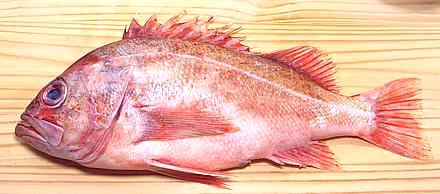 [Red Rock Cod; Sebastes miniatus]
[Red Rock Cod; Sebastes miniatus]
This rockfish is found from mid British Columbia, Canada south to mid Baja California, Mexico. It can grow to nearly 36 inches and 15 pounds, but the photo specimen was 17-1/2 inches and 3-1/2 pounds, about normal market size. It's a prized eating fish, but, as with other rockfish, the fishery is tightly regulated so it is available mainly along the Pacific coast of the U.S. and Canada.
More on Rockfish.
Vermilion flesh is tender, nearly white and has excellent flavor, light but not insipidely so. There is a thin layer of darker flesh right under the skin, mainly at the tail end, which is a bit stronger but not annoyingly so.
The flesh holds together well for any type of cooking, but does start to break into large flakes if simmered in soup. It is excellent poached or lightly powdered with rice flour and pan fried. It is not suitable for "whole fish" recipes because of skin shrink.
Buying: Vermilion can often be found in Asian markets in Los Angeles. It is a premium fish, but can sometimes be found on sale at as low as US $2.99 per pound. In other markets it may be sold as fillets mixed with other rockfish.
Scales: Vermilion is covered with fairly large thin scales that scrape off fairly easily and fly about only moderately.
Cleaning: There's nothing unusual in cleaning this fish, but the throat is quite strong, so cut it off with kitchen shears. The gills are large and fairly firmly attached, so cut them out with kitchen shears also.
Fillet: Vermilion is fairly easy to fillet with an easy to follow fin and bone structure, and the flesh holds together well. First cut off the head, turning the knife steeply under the gill covers to get the maximum amount of flesh. Outline the fillet by cutting through the skin along the top, across the tail and especially along the bottom. Cut from the top down following the bones to the backbone. Hop over the backbone at the tail and work forward. When I get to the ribcage I cut the ribs loose from the backbone with kitchen shears and pull them from the fillet with long nose pliers. They pull fairly easily and take almost no flesh. There are some very substantial centerline pin bones for the length of the body cavity but they are easy to locate. Pull them straight forward and they will come out fairly easily and cleanly. Method.
Yield: A 3-1/2 pound fish yielded 1 pound 11-1/2 ounces of skin-on fillets (49%) and 1 pound 9-1/2 ounces skin-off (46%). fillet weights nclude the skirt which is fleshy and quite usable (if your fish was fresh). There will still be some flesh around the pelvic (bottom) fins which can't be removed until after a short simmer.
Skin: Skin shrink is extreme and unrelenting - it doesn't release from the flesh at all and will curl even thick fillets into a tight cylinder. It should be removed for any method of cooking. This is a shame since it has no strong or "off" flavor, but it can be tossed into the stock pot with the bones. It is thin but quite strong so it's easy to remove by the standard long knife and cutting board Method. Almost no flesh should be lost.
Stock: The head, fins and bones simmered slowly for 30 to 40 minutes make an excellent, almost clear stock with a light, pleasant flavor - it just needs a touch of salt to make soup. The stock will have a bit of oil which needs to be separated out - use your gravy separator.
sf_vermilz 2006 r 110629 - www.clovegarden.com